American firms AM General and Flyer Defense debuted new versions of vehicles from their respective product lines loaded with launchers for loitering munitions, more commonly referred to as “suicide drones,” at the Association of the U.S. Army’s main annual convention this year. This underscores ever-growing interest within the U.S. military, as well as among foreign forces, in integrating suicide drones, some types of which are capable of operating as part of larger networked swarms, onto various crewed and uncrewed vehicles. These drones can offer surveillance and reconnaissance capabilities, as well as the ability to carry out precision strikes, to even the smallest of units.
AM General’s offering is the Blade Edition of the company’s HUMVEE Saber vehicle, which it developed in cooperation with drone maker AeroVironment and remote weapon station manufacturer Hornet Defense.

“With the HUMVEE Saber Blade Edition, we continue to push the boundaries of lethality and protection on the battlefield, and we’re proud of the collective effort we fostered with AeroVironment and Hornet to bring this concept to life,” John Chadbourne, AM General Executive Vice President and Chief Business Development Officer, said in a statement ahead of the Association of the U.S. Army (AUSA) convention.
The major new features found on the Blade Edition are an array of launchers for AeroVironment Switchblade series suicide drones at the rear, as well as a Hornet Air Guard Remote Controlled Weapon System (RCWS) turret on top of the vehicle. The Air Guard RCWS, which features electro-optical and infrared cameras, a small radar, and a 40mm Heckler & Koch GMG automatic grenade launcher with air-bursting ammunition, is designed primarily for use against drones. The turret is capable of automatically warning the operator that a drone has been detected, when that can then be verified visually and engaged, according to Hornet.
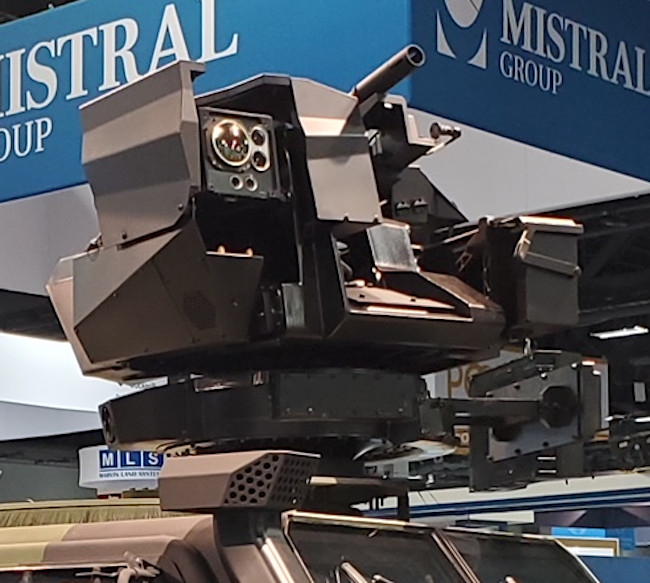

Drones, including weaponized commercial types, are being used by state and non-state actors now and present real threats that will only grow as time goes on. The U.S. military, in particular, after years of neglecting the short-range air defense mission broadly, has rushed to field new counter-drone systems in recent years.
There doesn’t seem to be any reason why the RCWS couldn’t be employed against various ground targets, as well.
When it comes to the suicide drone loadout, HUMVEE Saber Blade Edition can be loaded with up to 10 anti-armor-capable Switchblade 600 loitering munition in individual launch tubes, as well as four more of the smaller Switchblade 300s in specially designed cells, two on each side of the launcher assembly. Both types have electro-optical and infrared cameras in those noses and those feeds can be piped to operators on the ground via a tablet-like controller. This allows them to be used for surveillance and reconnaissance purposes, where they can then be used to immediately prosecute any targets that might emerge, as well as for striking known threats.

Though the Switchblades have a semi-autonomous-like control interface, there is an operator in the loop at all times. AeroVironment touts the ability of the Switchblade 300 and 600 to be waved off and recommitted to either the same target or another one should circumstances change suddenly, such as the appearance of innocent bystanders nearby.
AeroVironment has also talked about adding increased autonomy to the Switchblade series in the future, to include the potential for groups of them to operate as networked swarms. Swarms inherently have the ability to cover more ground quickly and to overwhelm enemy defenses. You can read more about the Switchblade’s genesis and where this family of loitering munitions might be headed in the future in this past War Zone feature.

When it comes to the underlying vehicle, it’s unclear how new the Humvee Saber, a derivative of the iconic High Mobility Multipurpose Wheeled Vehicle (HMMWV), actually is. Though the vehicle with this name was only unveiled earlier this year, it appears to be similar if not identical to a design called the HUMVEE NXT 360 that AM General rolled out in 2020. The company has promoted both the NXT 360 and the Saber as featuring all-new bodies that provide improved 360-degree protection, especially against mines and improvised explosive devices, as well as powertrain, suspension, and other improvements over standard Humvees.


Flyer Defense’s loitering munition-armed vehicle is based on the company F72-U, a configuration that the company has also marketed together with General Dynamics Ordnance and Tactical Systems (GD-OTS) as the Flyer 72 Tactical Utility Vehicle (TUV). The F72-U is a two-door variant of the Flyer 72 4×4 light vehicle with a pickup-style rear bed with fold-down side panels and a tailgate.
A launcher for Hero-120 loitering munitions has been installed on this new variant of the F72-U vehicle. It has 10 total cells, but only four of them hold Hero-120s in a ready-to-fire configuration, while the other six are simply for storing additional suicide drones. The example put on display at AUSA also features a 5.56x45mm M249 Squad Automatic Weapon on a swing-arm mount on the passenger side.
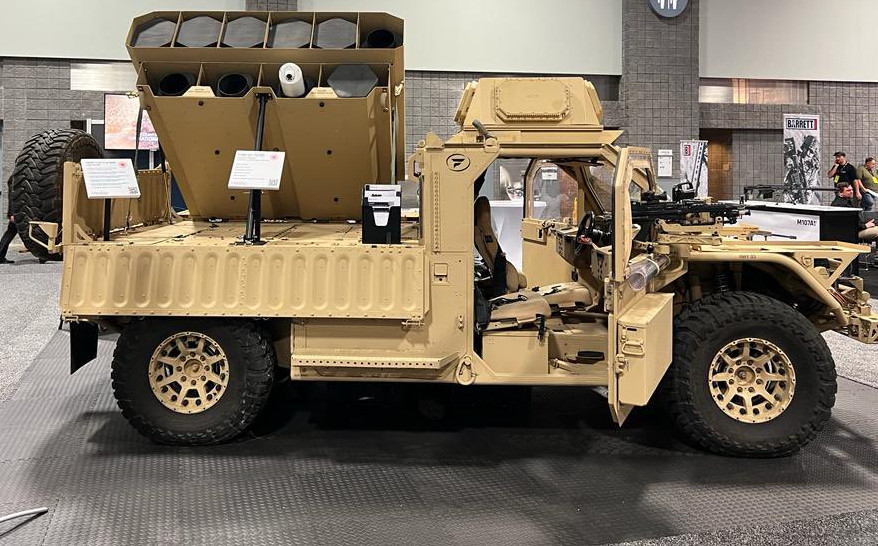

The Hero-120, examples of which are now being produced in the United States through a partnership between the original Israeli manufacturer UVision and Maryland-based Mistral, Inc., is similar on a very broad level in form and function to the AeroVironment Switchblade and is designed to provide similar strike and reconnaissance and surveillance capabilities. It too features an operator-in-the-loop control system that allows for manual control, including the ability to abort strikes very late in the terminal phase of flight. UVision has said that Hero-120s can also be recovered and refurbished for reuse if they complete a mission without striking a target, a capability that AeroVironment has said in the past that it hopes to add to the Switchblade family.

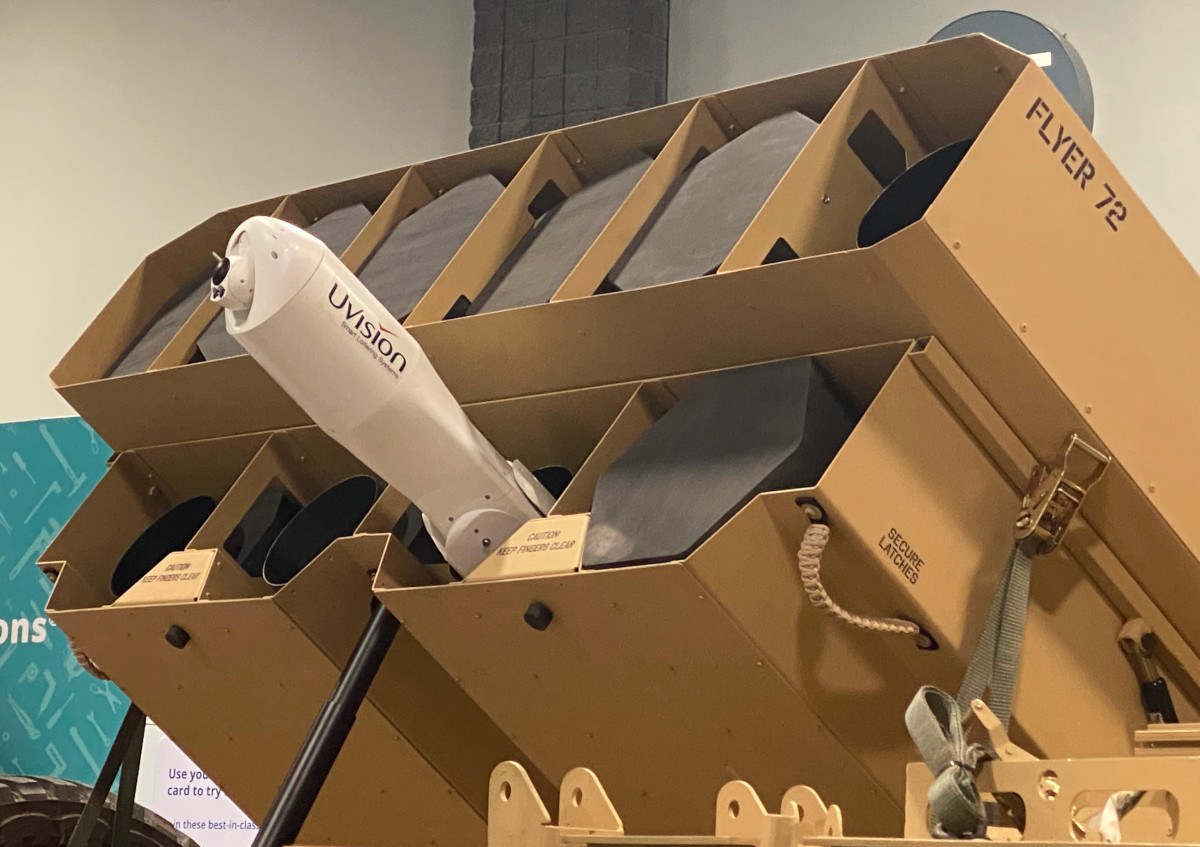
Continuing with the counter-drone theme, the F72-U that Flyer Defense brought to this year’s AUSA convention had a small radar system with four separate fixed arrays mounted on top of the cab. Company representatives told The War Zone that this system is primarily designed to automatically detect hostile loitering munitions and alert the crew and is unrelated to the Hero-120 launcher.
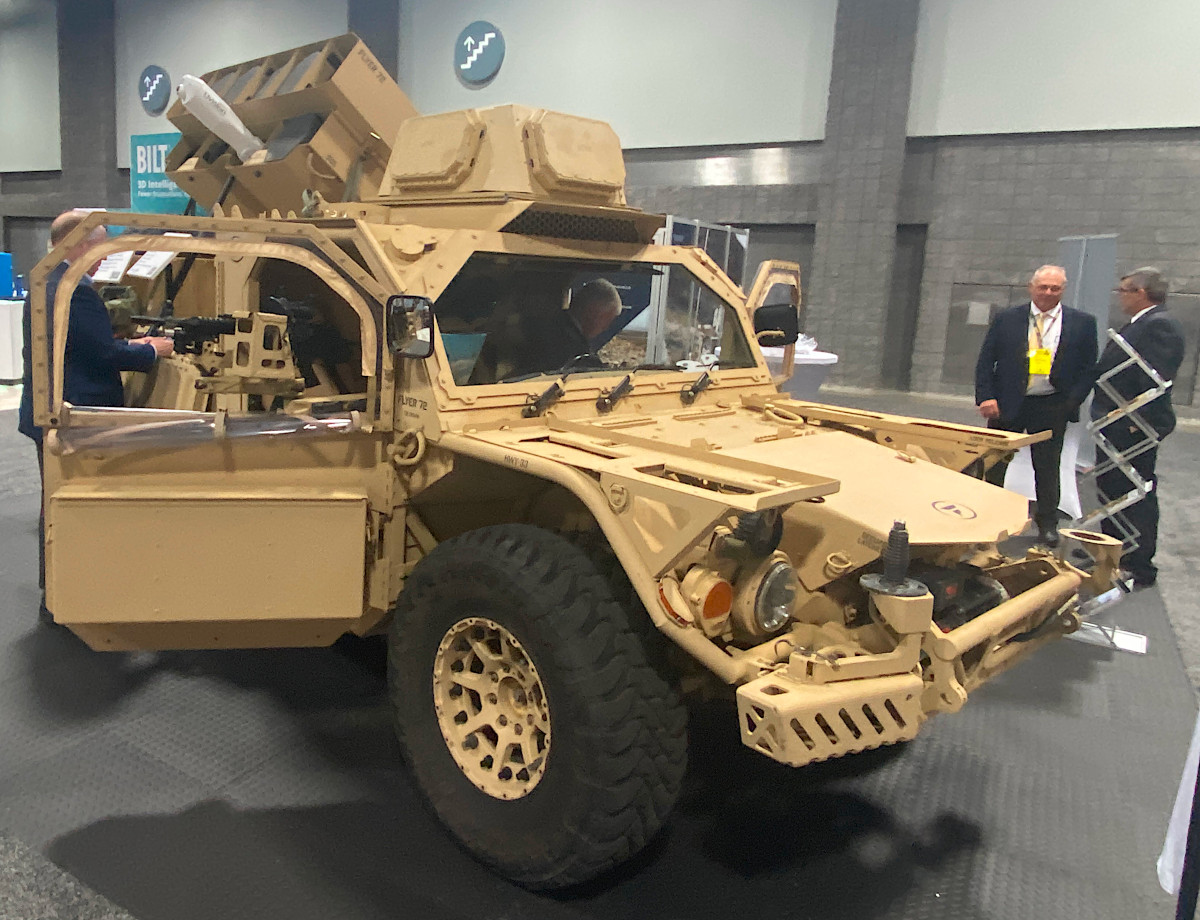
However, counter-drone systems do exist that actually use small drones to intercept incoming threats. As such, it might be possible to combine the radar and the launcher on the Flyer in the future to create a system capable of engaging hostile suicide drones and other uncrewed aircraft.
Both the HUMVEE Saber Blade Edition and the Hero-120-armed F72-U could provide valuable additional firepower, as well as surveillance and reconnaissance capabilities, to even relatively small units. The vehicles offer additional on and off-road mobility for these weapon systems, as well as the ability to carry more rounds at once and launch them in rapid succession, too. The Switchblade 300 and 600 and the Hero-120 can already be employed from single-tube man-portable launchers.
Mounting launchers for suicide drones on ground vehicles provides a way of quickly getting the munitions closer to potential targets, and then quickly withdrawing the launch platforms to safer areas, too. This could enable friendly forces to deploy small groups of them, or even full-on swarms, deeper into enemy-controlled territory, as well.
It’s unclear what impact the Hero-120 launch system might have on the F72-U’s overall transportability, but the base vehicle there is also small and light enough to be carried internally in some helicopters, like the CH-47 Chinook, as well as larger fixed-wing cargo aircraft. This could make it even easier to deploy rapidly for short-duration or other kinds of expeditionary or distributed operations. Flyer Defense representatives at the AUSA convention specifically highlighted the vehicle’s potential utility in special operations forces missions. Variants of the Flyer 72 are already in service with U.S. special operations forces units and U.S. Special Operations Command (SOCOM) is in the process of acquiring examples of the Hero-120SF variant.

Regardless, loiter-munition-armed vehicles, or at least the option of integrating these weapons onto a wide variety of crewed and uncrewed ground platforms, look set to become an increasingly standard component of modern military forces. For example, the U.S. Marine Corps is planning arm variants of the 8×8 LAV-25 light armored vehicle, as well as uncrewed surface vessels, with launchers for the Hero-120, as well as make loitering munitions available to dismounted units. The Army and the Navy are also exploring various surface-launched drone and loitering munition options, as air-launched types.
The HUMVEE Saber Blade Edition and F72-U with the Hero-120 launcher are just some examples of how industry is responding to this increasing demand, too. At the AUSA show this year, the U.S.-based subsidiary of German firm Rheinmetall publicly unveiled the version of its Lynx infantry fighting vehicle for the Army’s Optionally Manned Fighting Vehicle (OMFV) competition, which is seeking a successor to the Bradley Fighting Vehicle family. The OMFV configuration of the Lynx includes a multi-purpose launcher capable of firing Raytheon Coyote Block 3 loitering munitions, among other things.
In addition, defense contractor Anduril Industries exhibited a four-cell launcher for Area-I ALTIUS-600 drones, which can be configured as loitering munitions. Anduril purchased Area-I last year and also recently made an official announcement about suicide-drone versions of the ALTIUS-600 and the larger ALTIUS-700.
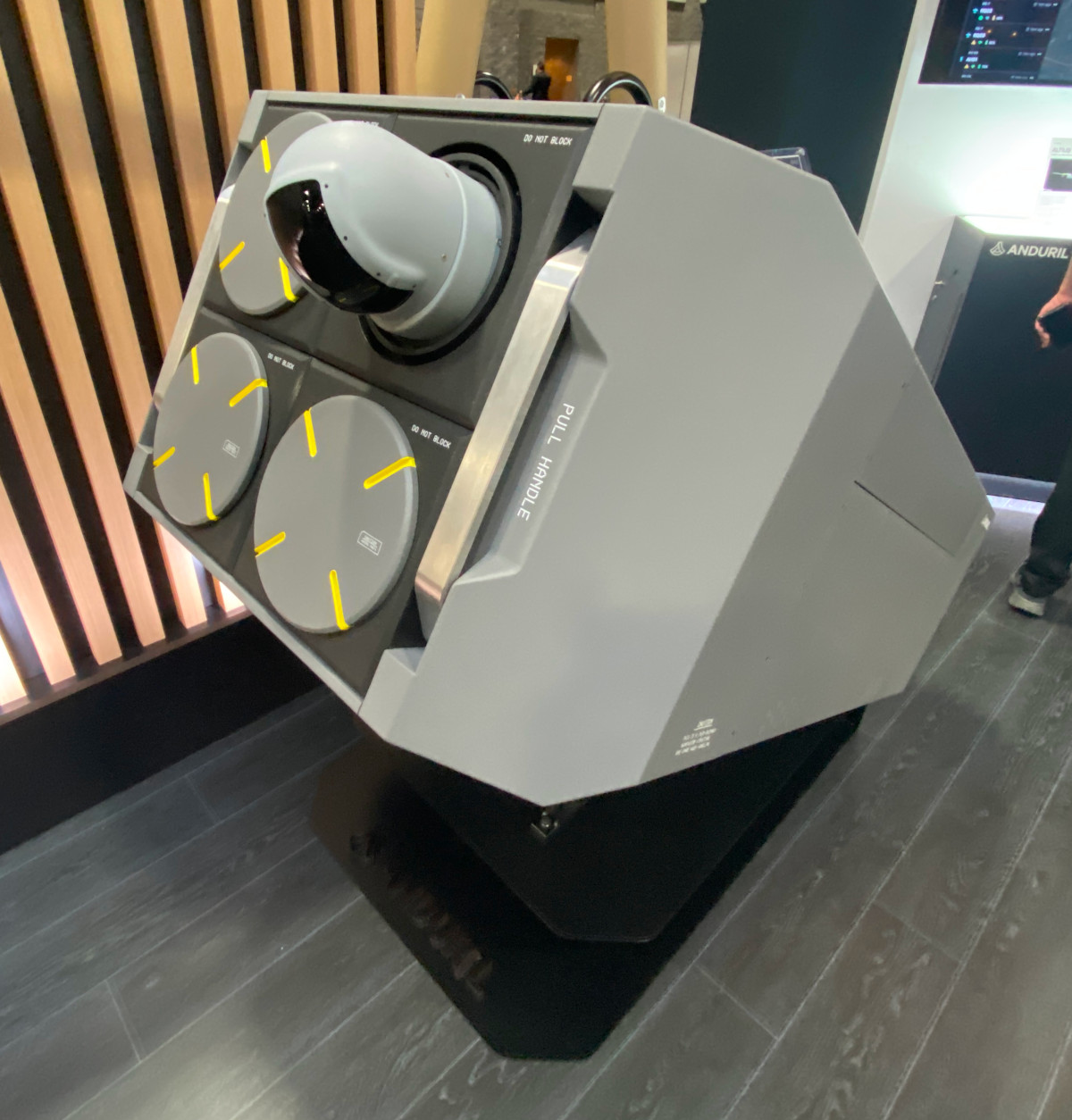
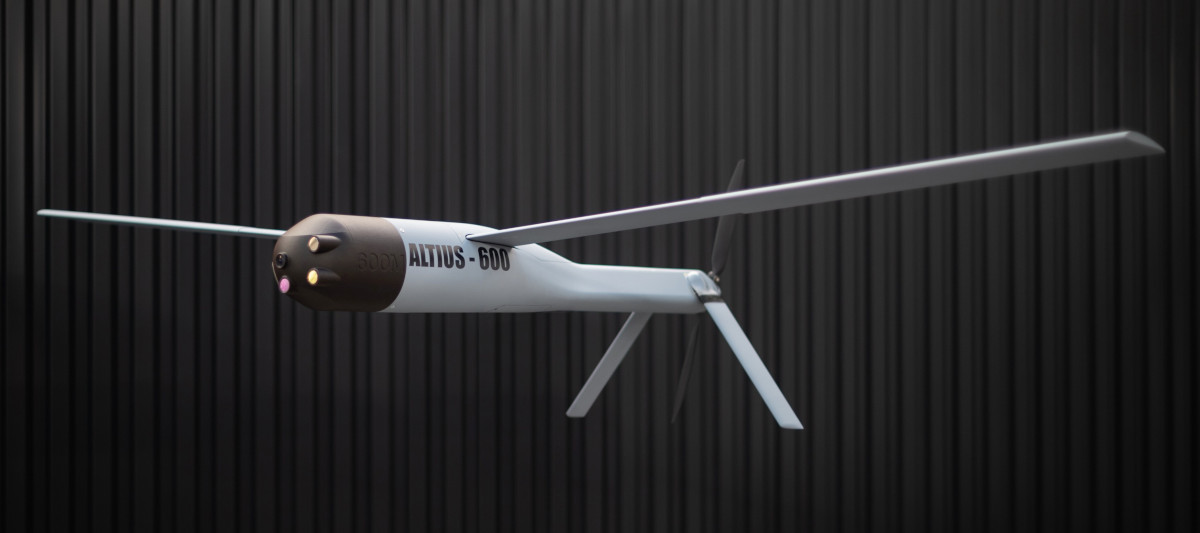
This launcher ‘pod’ is designed to be platform agnostic and can be installed on various vehicles. Unsurprisingly in the context of AUSA, the company specifically noted that the system could be fitted to various uncrewed ground vehicles (UGV) that the U.S. Army is testing as part of its Remote Combat Vehicle (RCV) program, as well as whatever design the service might pick as the winning OMFV design.
At last year’s AUSA convention, General Dynamics Land Systems had put a version of its TRX UGV capable of carrying 50 Switchblades – a mixture of 300 and 600 types – on display. You can read more about this vehicle here.
The ongoing conflict in Ukraine, where loitering munitions, including Switchblade 300s, along with other kinds of armed uncrewed systems, have seen significant use, is only likely to cement this trend.
All told, whether or not the U.S. Army, or any other potential customers, end up buying examples of the HUMVEE Saber Blade Edition and or Hero-120-equipped F72-U, there is clearly major interest from militaries around the world in suicide drones, and the ability the launch them in large numbers, potentially as swarms, from highly mobile ground vehicles and other platforms.
Dan Parsons contributed to this story from Washington, D.C.
Contact the authors: joe@thedrive.com and oliver@thewarzone.com
